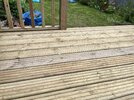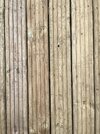- Joined
- 27 Apr 2024
- Messages
- 7
- Reaction score
- 0
- Country

Hey all - I recently had new decking fitted; overall, pleased with it but there's one panel that looks very notably different to the others. It is whiteish, and lacks the coppery green tint that the others have and which I believe comes from being tanalised. I realise that the panels will all naturally differ a bit in colour, as always with timbers, but this does look like there is something wrong - e.g. maybe this one wasn't treated/tanalised properly? Would welcome any insights people have - the colour differential is more pronounced in real life than it comes across in the photos. Many thanks. (Should be clear in photos which is the panel in question - about half way down one photo, and on the far left of the other).



